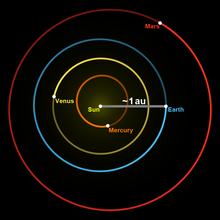| วัตถุ
|
ระยะทาง (AU)
|
ขนาด
|
คำอธิบายและหมายเหตุ
|
อ้างอิง
|
| โลก
|
0.0003
|
-
|
เส้นรอบวงของโลก ณ เส้นศูนย์สูตร (ราว 40075 กิโลเมตร หรือ 24901 ไมล์)
|
-
|
| วินาทีแสง
|
0.002
|
-
|
ระยะทางที่แสงเดินทางในเวลา 1 วินาที
|
-
|
| ดวงจันทร์
|
0.0026
|
–
|
ระยะทางเฉลี่ยจากโลก
|
-
|
| รัศมีดวงอาทิตย์
|
0.005
|
-
|
radius of the Sun (695500 km, 432450 mi, ~110 times the radius of the Earth or 10 times the average radius of Jupiter)
|
-
|
| Lagrangian point
|
0.01
|
-
|
The Lagrangian point L2 is about 1500000 กิโลเมตร (930000 ไมล์) from Earth. Unmanned space missions, such as the James Webb Space Telescope, Planck and Gaia take advantage of this sun-shielded location.
|
[1]
|
| นาทีแสง
|
0.12
|
-
|
ระยะทางที่แสงเดินทางในเวลา 1 นาที
|
-
|
| ดาวพุธ
|
0.39
|
–
|
ระยะทางเฉลี่ยจากดวงอาทิตย์
|
-
|
| ดาวศุกร์
|
0.72
|
–
|
ระยะทางเฉลี่ยจากดวงอาทิตย์
|
-
|
| โลก
|
1.00
|
–
|
average distance of the Earth's orbit from the Sun (Sunlight travels for 8 minutes and 19 seconds before reaching the Earth.)
|
-
|
| ดาวอังคาร
|
1.52
|
–
|
ระยะทางเฉลี่ยจากดวงอาทิตย์
|
-
|
| ดาวซีรีส
|
2.77
|
–
|
average distance from the Sun. The only dwarf planet in the asteroid belt.
|
-
|
| ดาวพฤหัสบดี
|
5.20
|
–
|
ระยะทางเฉลี่ยจากดวงอาทิตย์
|
-
|
| ดาวบีเทลจุส
|
5.5
|
-
|
star's mean diameter (It is a red supergiant with about 1000 solar radii.)
|
-
|
| ชั่วโมงแสง
|
7.2
|
-
|
ระยะทางที่แสงเดินทางในเวลา 1 ชั่วโมง
|
-
|
| NML Cygni
|
7.67
|
-
|
radius of one of the largest known stars
|
-
|
| ดาวเสาร์
|
9.58
|
–
|
ระยะทางเฉลี่ยจากดวงอาทิตย์
|
-
|
| ดาวยูเรนัส (ดาวมฤตยู)
|
19.23
|
–
|
ระยะทางเฉลี่ยจากดวงอาทิตย์
|
-
|
| ดาวเนปจูน (ดาวสมุทร/ดาวเกตุ)
|
30.10
|
–
|
ระยะทางเฉลี่ยจากดวงอาทิตย์
|
-
|
| Kuiper belt
|
30
|
-
|
begins at roughly that distance from the Sun
|
[2]
|
| นิวฮอไรซันส์
|
32.92
|
-
|
spacecraft's distance from the Sun, ข้อมูลเมื่อ 16 กรกฎาคม ค.ศ. 2015 (2015 -07-16)[update]
|
[3]
|
| ดาวพลูโต
|
39.3
|
–
|
average distance from the Sun (It varies by 9.6 AU due to the dwarf planet's elliptic orbit.)
|
-
|
| Scattered disc
|
45
|
-
|
roughly begins at that distance from the Sun (it overlaps with the Kuiper belt.)
|
-
|
| Kuiper belt
|
50
|
± 3
|
ends at that distance from the Sun
|
-
|
| Eris
|
67.8
|
-
|
its semi-major axis
|
-
|
| 90377 เซดนา
|
76
|
-
|
closest distance from the Sun (perihelion)
|
-
|
| 90377 เซดนา
|
87
|
-
|
distance from the Sun ข้อมูลเมื่อ 2012[update] (It is an object of the scattered disc and takes 11400 years to orbit the Sun.)
|
[4]
|
| Termination shock
|
94
|
-
|
distance from the Sun of boundary between solar winds/interstellar winds/interstellar medium
|
-
|
| Eris
|
96.4
|
-
|
distance from the Sun ข้อมูลเมื่อ 2014[update] (Eris and its moon are currently the most distant known objects in the Solar System apart from long-period comets and space probes, and roughly three times as far as Pluto.)
|
[5]
|
| Heliosheath
|
100
|
-
|
the region of the heliosphere beyond the termination shock, where the solar wind is slowed down, more turbulent and compressed due to the interstellar medium
|
-
|
| วอยเอจเจอร์ 1
|
125
|
-
|
ข้อมูลเมื่อ สิงหาคม 2013[update], the space probe is the furthest human-made object from the Sun. It is traveling at about 3.5 astronomical units per year.
|
[6]
|
| Light-day
|
173
|
-
|
distance light travels in one day
|
-
|
| 90377 เซดนา
|
942
|
-
|
farthest distance from the Sun (aphelion)
|
-
|
| จุดเริ่มต้นขอบเขตชั้นในของเมฆออร์ต
|
2000
|
± 1000
|
beginning of Hills cloud (It is the inner part of the Oort cloud and shaped like a disc or doughnut.)
|
-
|
| จุบสิ้นสุดขอบเขตชั้นในของเมฆออร์ต
|
20000
|
-
|
end of the inner Oort cloud, beginning of outer Oort cloud, which is weakly bound to the Sun and believed to have a spherical shape
|
-
|
| ปีแสง
|
63241
|
-
|
ระยะทางที่แสงเดินทางในเวลา 1 ปี (365.25 วัน)
|
-
|
| จุดสิ้นสุด
เมฆออร์ต
|
75000
|
± 25000
|
distance of the outer limit of Oort cloud from the Sun (estimated, corresponds to 1.2 light-years)
|
-
|
| Parsec
|
206265
|
-
|
one parsec (The parsec is defined in terms of the astronomical unit, is used to measure distances beyond the scope of the Solar System and is about 3.26 light-years.)
|
[7]
|
| Hill/Roche sphere
|
230000
|
-
|
maximum extent of the Sun's gravitational field, beyond this is true interstellar medium (~3.6 light-years)
|
[8]
|
| ดาวพร็อกซิมาคนครึ่งม้า
|
268000
|
± 126
|
ระยะทางจากดาวฤกษ์ที่ใกล้ระบบสุริยะมากที่สุด
|
-
|
| ดาวซิริอุส (ดาวโจร)
|
544000
|
-
|
ระยะทางจากดาวฤกษ์ที่สว่างมากที่สุด (ประมาณ 8.6 ปีแสง)
|
-
|
| ดาวบีเทลจุส
|
40663000
|
-
|
distance to the star in the constellation of Orion (~643 light-years)
|
-
|
| จุดกึ่งกลาง กาแลคซีทางช้างเผือก
|
1700000000
|
-
|
ระยะทางจากดวงอาทิตย์จนถึงจุกกึ่งกลางของ กาแลคซีทางช้างเผือก
|
-
|
| Note: figures in this table are generally rounded, estimates, often rough estimates, and may considerably differ from other sources. Table also includes other units of length for comparison.
|
